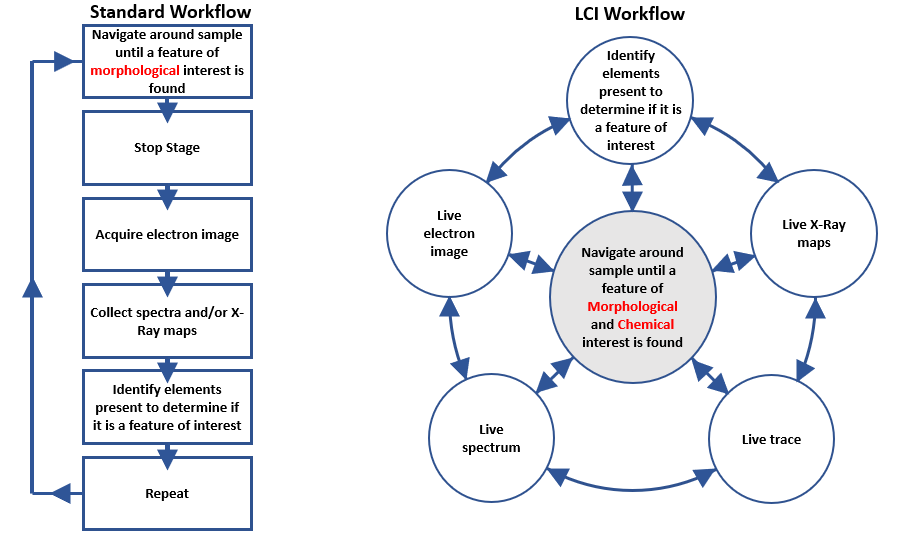In this interview AZoM talks to Anthony Hyde about the AZtec Live Chemical Imaging its applications, benefits and features.
Can you explain what live chemical imaging is?
Live Chemical Imaging is the capability to view morphology and elemental distributions simultaneously and continuously as you investigate your sample in an SEM, even while the sample stage is moving.
When and how is live chemical imaging used?
Every SEM user does the same thing when they put a new sample into their microscope. They turn the electron beam on and move around their sample using the sample stage while viewing a live scanning electron image. They do this to either quickly gain an overall view of their sample or find a particular feature of interest that may require a more focused investigation.
With LCI, users do the same, but instead of an electron image, they now have a ‘colored’ image, with colors representing elemental distributions. So that, when users move around their sample, they receive far more information to help lead their navigation or investigation.
What differentiates AZtec Live from other chemical imaging systems?
The primary and most critical difference is that the Live Chemical Imaging capability within AZtecLive gives users chemical distribution information while the stage is moving.
Other systems must wait until the stage has stopped before delivering this information. Alternatively, you could say that other systems cannot show a colored image until they stop moving the stage.
What makes AZtec Live groundbreaking?
The capability to acquire vast amounts of X-Ray data and process it in real-time was unheard of before LCI was introduced. Until recently, the quality of data that is delivered by LCI each second would take systems minutes or even hours to acquire.
The large area Ultim detectors, high throughput electronics, and innovative multi-threaded software have made real-time analysis of this kind a reality.

Image Credit: Oxford Instruments NanoAnalysis
What are some of the features of AZtec Live with which users of previous systems will be familiar?
Effectively, we use the core mapping facilities that people will already tend to use.
Instead of using them in a finite and static acquisition, where they decide on a resolution and number of frames, however, we use them in a continuous and dynamic way so that the user only has to press the start button and the interface automatically presents them with a wealth of information that updates as they move the stage.
What are some of the novel features unique to AZtec Live?
The ability to automatically switch modes of imaging when stationary and moving are some unique features of AZtec Live. This means that the user does not have to do anything when they stop to take a closer look at something. The system will detect that the stage has stopped moving and switch from the fast Dynamic mode to the static Integration mode.
The user will notice an immediate improvement in data quality, meaning they can pick up fine detail in their sample.
The autolayer function looks at the X-Ray maps that have been automatically selected and ranks them in terms of intensity and inhomogeneity, assigns them a color, and overlays the most interesting maps on the electron image to create the colored (Layered) image.
How do colored images improve sample investigations?
Colored images enable the user to process topography and spatial elemental information in one easy-to-interpret image instead of switching between electron image X-Ray maps and a spectrum.
What benefits does Aztec Live deliver in terms of EDS analysis?
The crucial thing is that LCI can augment and improve the user's standard EDS analysis. It delivers a productivity improvement and also a certainty that the user will quickly find what they are looking for or to look at it another way, and it gives them confidence that they will not miss vital information.
OxInst - Ceramic Aug 2022
Credit: Oxford Instruments NanoAnalysis
How does Aztec Live eliminate the stop-start workflow of such analysis?
The classic Stop-Start analysis refers to the user moving around their sample with a live electron image from the microscope. When they see something of interest, they stop the stage and then turn to the EDS system to acquire spectra or maps to determine the chemical composition.
Then they return to the SEM and start moving around while watching the electron image. With LCI, we show that live electron image in our EDS software and overlay the chemical information in the form of X-Ray maps, so the user no longer needs to stop and switch from the SEM to the EDS system.
What benefits does this confer to the end user?
In terms of benefits, the user will experience an increase in productivity and confidence. They will be able to find areas of interest and investigate more of their sample quicker. The continuous chemical feedback, even when the stage is moving, means that they are less likely to miss features of interest
What is live trace, and how will this help Aztec Live users?
Live trace records where the user has been on the sample and what elements they have detected. This helps the user see if they have analyzed a representative area of their sample.
It also allows them to see what elements have been detected and where on the sample they are located. If there is a particular area that they are interested in, they can use the Live Trace to drive the stage back to it for further analysis.
About Anthony Hyde
Anthony Hyde graduated with a BSc in Physics and has worked in the field of electron microscopy for the past 34 years, 22 of which have been with Oxford Instruments. He currently works as an EDS product manager, where he helps design, develop and market new EDS software and hardware.

This information has been sourced, reviewed and adapted from materials provided by Oxford Instruments NanoAnalysis.
For more information on this source, please visit Oxford Instruments NanoAnalysis.
Disclaimer: The views expressed here are those of the interviewee and do not necessarily represent the views of AZoM.com Limited (T/A) AZoNetwork, the owner and operator of this website. This disclaimer forms part of the Terms and Conditions of use of this website.